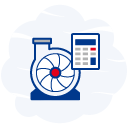Pump installation tips
The pump installation tips listed below are general and mainly related to mobile pumps. You will find much more detailed information in the user manual provided. There you can also read all about safety and working safely with pumps and piping systems.Safety instructions pumps on public ground
- The management must be in possession of a permit to work on public roads or public grounds, if required by local legislation.
- Use safety barriers, along with red/white cones, around the work area of the pump and pipes.
- Place red/white warning signs against each safety barrier.
- Providing crossings for pedestrians and cyclists where pipes cross a footpath or cycle path.
- Use composite hose and pipe protection road ramps if necessary.
- Ensure that the pumpset is adequately illuminated so it is visible to all road users.
- Place a light on each safety barrier (not a flashing light) and switch it on.
- If a pumpset is set to automatic level control or is equipped with a remote control, the management must provide adequate safety measures and notifications that the pumpset can start at any time.
Pump placement
- Place the pumpset on a flat surface capable of supporting the load.
- Make sure the pump is placed in such a manner that it is not subjected to distorting forces.
- Ensure there is sufficient space around the pumpset for operation and maintenance activities.
- Install the prescribed safeguards and warning signs in the correct manner.
- Make sure that nothing is covering any of the air channels of the pumpset.
- Always prevent water from entering the pumpset through the air channels in the canopy as a result of environmental factors (such as on board a ship or under a conveyor belt).
- The standard pumps are not suitable for placement in a potentially flammable or explosive atmosphere. We manufacture special ATEX certified pumps for such applications.
- In case of an open unit, or electric pumpset pay attention to the IP protection class of electrical components and do not exceed the ratings of the electric motor in terms of insulation class and protection class.
Pump installation
- Follow all legal and local lifting guidelines when installing the pump.
- Install the pumpset as close as possible to the pumped liquid or waterline.
- When pumping dirty water with solids or raw sewage water, install a strainer at the beginning of the suction line.
- Make sure that the fluid intake – suction strainer – will remain sufficiently submerged beneath the waterline so no air will be drawn in even when the fluid is at its lowest level.
- Ensure that there is no vortex near the inlet of the suction line.
- After the pumpset has been installed correctly, the final alignment between the pump and the drive must be checked and corrected if necessary. This does not apply to pumpsets with an SAE engine flange connection or a cardan shaft.
- For pumps in parallel setups always install a non-return valve in the discharge pipe after each pump.
- For pumps in series always check that the maximum pressure in the installation does not exceed the permissible pumps and system pressure.
Piping guidelines
- Select the diameter and length of the suction and delivery pipes as well as those of any additional components such that the inlet pressure remains above the minimum allowable value. The operating pressure must not exceed the maximum allowable value.
- Use our tools (table recommended suction pipe diameter and head calculator) to determine the correct dimensions of the piping system in combination with the pump.
- Always make sure that the suction and discharge lines are well supported (during the pumping process, the total weight increases enormously).
- When there is a change of diameter in the piping, use an eccentric reducer to prevent the accumulation of air.
- In the case of vibration and/or hot liquids, install expansion elements in the pipes.
- If there is a risk of water hammer, install a bypass, accumulator or pressure protection in the discharge line.
- If there is a possibility that a backflow of liquid could cause the pump to turn in the opposite direction when stopped, a non-return valve or shut-off valve must be placed in the piping to prevent this.
- Install measurement instruments in the piping for monitoring during operation.
Do you have questions concerning the installation of your pump? Please contact us for advice.
Failure to follow the guidelines for the placement and installation of the pumpset can result in danger to the user and/or severe damage to the pump or pumpset. BBA Pumps is not responsible for accidents and damage that result from failure to follow the guidelines. Such use results in forfeiture of the right to assert any warranty or damage compensation claims.





